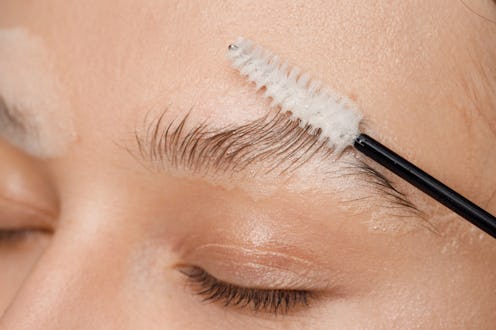(Makeup)
5 TikTok Beauty Hacks That Will Actually Improve Your Routine
No gimmicks here.

In addition to being the source of your midday procrastination, TikTok is home to a plethora of beauty tips and tricks. While some of the platform’s most popular beauty hacks are gimmicky for the sake of virality, others are actually incredibly useful — and could be a game-changer for your routine. However, considering the vastness of the video-sharing app, it can be tough to suss out which is which.
While there’s certainly no “right” or “wrong” way to do your makeup, there are certain techniques that can help you achieve a desired look — techniques that, though effective, are perhaps not the traditional way of doing things. You may have never thought to put soap in your eyebrows or apply your mascara backward — and why would you? Therein lies the beauty of the internet; apps like TikTok allow viewers and creators to share the helpful hacks they’ve picked up to an audience that otherwise, they probably would have never crossed paths with.
From how to achieve the perfect subtly tinted lip to giving yourself a natural face lift using blush, discover below the five best TikTok beauty hacks that have actually worked for people — both on the app and in real life.
Get Pink Lips Using Red Lipstick
On the hunt for a perfectly subtle lip color? This simple lipstick hack, shared by TikTok user @glamzilla, could not be easier. All you have to do is dot a bit of your favorite red lipstick in the middle of your lips, then blend it out with your finger. The result is an instant stained effect that looks so natural and effortless (because it is).
Soap Brows
This technique is quite literally what it sounds like; it involves applying soap into the eyebrows in order to achieve a laminated effect. It seems too good to be true, but it’s actually a foolproof way to set brows in place — plus, it’s much more affordable than purchasing a brow gel. Simply dampen a spoolie brush with water, coat it in soap (use a clear bar soap) and brush through your eyebrows. You can add brow pencil if you want to fill in any sparse areas, or leave them be for a perfectly brushed-up look.
Reverse Mascara Application
Mascara clumping is a deeply frustrating and an all too common problem. Even with the best mascara formulas and nicest bristles, applying multiple coats can often result in a clumpy disaster. Using the Maybelline Falsies Lash Lift, creator @mirellabelle shared how she applies three layers of mascara; she starts with a coat on the very tip of the lashes, then a second from the middle of the lashes, then a third starting at the root. She adds that not only does this technique help reduce clumping, it prevents your lashes from getting weighed down by excess product — helping them to keep their curl for longer.
Concealed Pimples
Concealing acne can be challenging; too much coverage and it looks cakey, too little and the redness shows through. A simple spot-concealing hack recently went viral on TikTok for its no-fuss approach to coverage, and it really does work. First, prime your skin with a gripping primer like the Milk Makeup Hydro Grip. Then, use a smaller brush to apply a full-coverage concealer to any spots you might have — in @sydneyskunberg’s video, she uses NARS Soft Matte Complete Concealer. Let the concealer dry for one to two minutes, then apply your foundation on top, without blending the concealer first. Voila: an even complexion without layer upon crusty layer of concealer.
Face-Lifting Blush
Most of us are taught that blush should go on the apples of the cheeks for a nice, rosy glow. While there’s absolutely nothing wrong with this technique, TikTok users have been sharing a blush application hack that’s a total game-changer if you’re after a more “snatched” look. By simply applying blush higher up on your cheeks (and blended up toward your temples), your face looks instantly lifted. Magic.
This article was originally published on